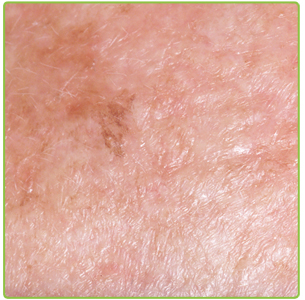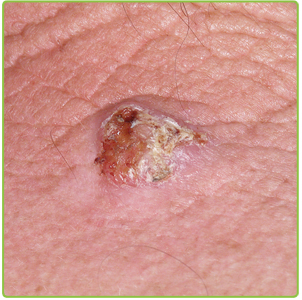 |
 |
| Skin Cancer |
 |
| Actinic Keratosis |
 |
| Actinic keratoses are considered “precancers,” and have the potential to turn into squamous cell carcinomas. Actinic keratoses appear as small pink or red spots with a rough surface, usually on sun-exposed areas. They may be more easily felt than seen. Early treatment of actinic keratoses can prevent their transformation into more serious squamous cell carcinomas. Actinic keratoses are usually treated with cryotherapy (freezing with liquid nitrogen) or by application of chemotherapy or immune enhancing cream. |
 |
|
 |
| Basal Cell Carcinoma |
 |
 |
Basal cell carcinoma is the most common in the general population and usually appears as a small, pink bump or patch on the head or neck, although it may occur on any part of the body. If untreated, the area will begin to open, bleed, or crust repeatedly. Basal cell carcinomas grow slowly but rarely spread to other parts of the body. However, if left untreated, basal cell carcinomas can cause extensive damage to the area involved. |
|
 |
| Squamous Cell Carcinoma |
 |
| Squamous cell carcinomas are the most common skin cancers in organ transplant patients. Squamous cell carcinomas is 65 times more common in transplant recipients than in the general population. Squamous cell carcinomas can look similar to basal cell carcinomas, but are usually more scaly and stick out further from the skin’s surface. Squamous cell carcinomas often occur on the head and neck, and have a special tendency to grow on the ears, lips, and the backs of hands and arms. If treated early, squamous cell carcinoma is curable. However, if the tumor invades deeply, it can spread to the lymph nodes, which then must be removed. If treatment is unsuccessful, squamous cell carcinoma spreads internally and results in death. |
 |
|
 |
| Malignant Melanoma |
 |
 |
Melanoma is four times more common in organ transplant recipients, than people without transplants. Unlike squamous cell carcinoma and basal cell carcinoma, malignant melanoma usually appears as an irregular brown spot or changing mole. Melanoma can arise from normal skin or from a mole, which has turned bad. If caught early, melanoma is usually curable. However, if it spreads to other parts of the body, it can result in death. |
|
 |
 |
|
 |
|








